How To STOP Over Rotating Back Foot & Squishing Bug For Baseball And Softball In 2022 | Hitting Drills To Properly Use Legs, Keep Back Foot Down OR Lift Back Foot
Keep ‘Back Foot Sideways’ Like Robinson Cano?
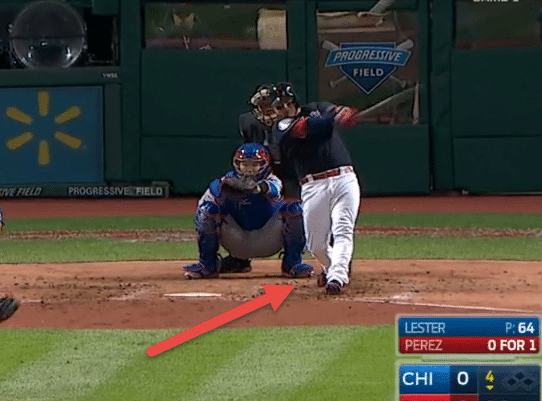
This is Roberto Perez’s 1st dinger in Game 1 of the 2016 World Series. It was to LF, and look at the back foot. Photo courtesy: MLB.com
This post will go over how to STOP over rotating the back foot (is that possible?) and explain why squishing the bug is bad for baseball and softball 2022. Discover hitting drills to properly use legs, keep back foot down OR back foot when swinging?
I wanted to do a follow up on the Matt Nokes post from a few weeks ago.
I received quite a few emails, like the following, from coaches who were a little confused as to what Nokes’s referred to as ‘back foot sideways’…
So I decided to do a short video (I know, a rarity these days :-P), seeing if I could bring some clarity to the issue.
Brian Clahane from Canada had emailed a comment about the Nokes post:
“Hey Joey, It’s Brian again…So you really have me thinking about this back foot sideways thing. I have been watching video and looking at still flip screens I have of hitters and I have to tell you I only see evidence of it on outside pitches or pitches hitters were late on.(Mccutchen and Miggie quite often when going other way)
I sent you this video of Cano to look at 1-because I know you use him as an example a lot and 2-because I found it under your name even though Chas Pippitt doing breakdown. Video shows what I keep seeing in that back foot rotated forward and normally as in this case off ground completely (not sideways). If I am misinterpreting what keeping back foot sideways at contact means, please explain because it’s driving me crazy thinking I’m missing something! I just keep seeing back foot forward at contact. Thanks, Brian”
The bottom line…
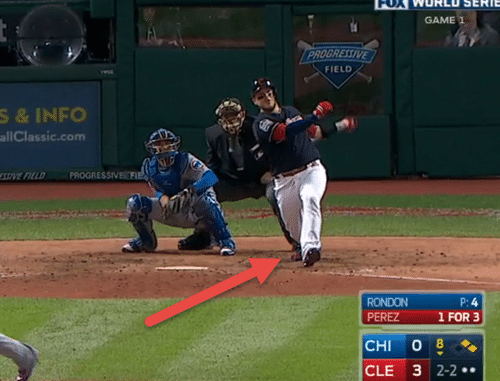
Here’s Roberto Perez’s 2nd dinger in Game 1 of 2016 WS. It was to LCF. Look at his back foot. Photo courtesy: MLB.com
- When looking at video, the chest view IS NOT helpful. Look for pitcher’s, catcher’s side, or over head views.
- The principle is to get the pelvis (or hips) perpendicular to impact, NOT to the pitcher.
- The back foot skips in some cases, and not so much in others. I’ve seen it skip away from home plate, toward the front foot, and toward the plate (not as often). In other words, you don’t have to have one without the other.
- What may also help are these two shifting foot pressure videos (Mickey Mantle AND RopeBat).
- One of the cues I liked came from Mark Meger from the Matt Nokes post, “With our 13U kids we do emphasize the rear hip drive but we shun turning that back foot. That should happen after contact as shown here.”
- The sideways back foot will deviate slightly depending on an inside v. outside pitch.
- This falls in line with this post on the 90-degree to the spine rule.
- In YouTube, search “[favorite player’s name] 2016 highlights”, and watch the behavior of the back foot at impact, and make note of batted ball direction.
- Also, it doesn’t seem ONLY .300 hitters do this because Roberto Perez, in the images above, is a career .220 hitter.
- My observation is the back foot acts like a “governor” to the rotation of the hips. It’s like it helps anchor down the back hip from over rotating the impact zone.
- Doing this helps to align the body on the plane of the pitch better, and may cut down on rolling over versus a full rotation of the hips, on every pitch.
- Zepp experiment coming soon from HPL on this 😉
Please post any concerns, counter-arguments, and/or observations below…
- Fix Your Little Leaguer’s Hitting Slump Fast – Proven Confidence Drills & Mental Reset Tools (Used by Top Youth Baseball Coaches) - July 9, 2025
- Best Hitting Drills for 8-Year-Olds (2025): Fix Swing Flaws Fast with This MLB-Trusted Youth Baseball System—At-Home, Step-by-Step, and Built for Game-Day Confidence - July 5, 2025
- Best Youth Baseball Hitting Program to Boost Rotational Power Fast—Trusted by MLB’s Rajai Davis & Built on the Catapult Loading System - June 22, 2025



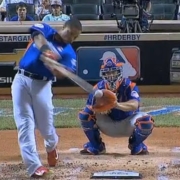

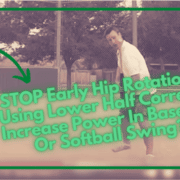
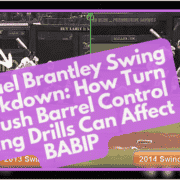






This helps make things a little more clear. I’m still working through this. I apologize for thinking out loud here…
I am more comfortable with the notion of getting the belt perpendicular to impact than I am trying to find the teach for the back foot. I think sometimes video can let us see too much and we lose sight of cause and effect and sequence. We see “hips before hands” in frame by frame videos of professional athletes and try to take that into the cage with 9 year olds. We see heads “fly out” but don’t ask why. We don’t understand why they still do it when every dad continues to shout out to “keep your head in”. I don’t feel that most “hitting flaws” typically occur in isolation. I think these conversations are sometimes difficult because sometimes our own coaching cues are more mental cues and not mechanics cues. I almost have a different language with each one of my players. I think the teach here is more about hitting the ball where we should than it is about a belt buckle. I could see teaching a player with cues such as, “Get that belt buckle around” more if they are constantly late on pitches they should be driving to center or even pulling. Other players who move more efficiently and attack the ball where it should be attacked may never hear that cue. There’s almost a non-teach here. It seems to me that the action of the back foot is far less relevant to the actions taken by the body preceding it. I really like what Mark said, “With our 13U kids we do emphasize the rear hip drive but we shun turning that back foot. That should happen after contact as shown here.”
I agree 100% Gavin. Causation does not necessarily equal correlation in most cases. If I wear a green shirt and it rains three days in a row…wearing the green shirt doesn’t make me a “bringer of rain” 😛 We have to strike at the root. I think awareness of the belt buckle is a good place to start. Although with different learning styles, that may not work for other hitters.
What I find, even with “Feel” learners, them getting a concept can mean using a different area of the body as a cue. In other words, ‘belt buckle’ may work for one but not another…and for the latter, they may like keeping the back foot rooted. It all depends on the hitter and your approach. Sometimes it may take 2-4 cues in a session to finally unlock the pathway to power for a particular hitter.
Hi –
Interesting post. I think you mean “correlation doesn’t mean causation”. Semantics aside, my 16y.o. son works out and has great lower, middle and upper body strength. When he bats (RH) and doesn’t rotate his back foot he hits weakly to RF, whereas when he rotates the back foot he pulls to LF with far more power.
This is coincident at times when he bends his front knee, and perhaps a straighter front leg would help the issue. A bent front leg isn’t good technique, irrespective of the back foot as it bleeds power.
I’ve told him to keep weight on the balls of his feet so when his hips lead the swing his back foot isn’t digging into the dirt sideways preventing rotation, but it’s the hips leading the swing, not the back foot. It should be there along for the ride, IMO, and not the driving force behind the swing. Perhaps that’s the crux of the post and I’ve just missed it.
Are there recommended drills to help with this?
Thanks for any helpful thoughts.
Most likely, the weak hits to the opposite field are a result of not controlling the barrel. Dropping it too early. In my experience, hitters are rotating way too much with lower, upper, or both. The lower half sets the stage to stay between the lines. Over rotation pushes force outside the lines, which makes for weak contact to the opposite field. I think your son’s biggest challenge is with barrel path, not MORE rotation of lower half. This is our second most important hitting strategy (of 7): controlling verticals. This post was ahead of its time (and in a lot of cases, it still is!):
https://hittingperformancelab.com/hitters-baseball/
In a nutshell, if pitch is middle in or middle up in the zone, then hitter MUST ‘swing down’. If pitch is middle down or middle away, then hitter MUST ‘swing up’. Please let me know if you have any questions on this Steve.
Great article… Pretty awesome!!! If I can, lets notice where the back knee is pointed just a moment prior to release…taking a different angle… As the hands are active, the feet are too… So there’s a hands to elbow and feet to the knees active notion while the elbows to knees including the core are positioning and being active and engaged… Now the feet are active in screwing into the ground and dosiflexion and plantar flexion… Blah…blah… Blah… Said another way, there’s a feet to knees, knees to elbows and elbows to hands togetherness while using some interdependent actions along the way in order to bring it all together…
Your right in when you said positioning… This is to position yourself to square the ball as I see
” square”…. So for example, on a golf club you have that flat surface you want to hit and any deviation you slice or fade or whatever as I’m not a golfer… If we put a piece of square tape on the bat, than if you hit outside that tape your not square or your not transferring all your energy and you can’t direct the ball much… But in baseball the bat has no feedback mechanism like the golf club… So you might hit line drives and not notice… I guess… You can get crazy pull happy and cut the ball… I’m not saying you can’t do well that way just saying it’s not the best way of doing it…. And for sure the outside pitch would be hard to hit if you over rotate your POSITION…. Just think of golfers… Now Golfers have the ball in the same location and not moving so there back foot looks the same as ours adjust to the ball… Again ours adjust to the ball by our positioning…. Said another way, we position our center of mass ( think core of knees to elbows) to transfer our energy best to the ground and back to the bat head with our limbs…
Damn it… Tried to make it short… Sorry.. Hopefully a different angle on the same thing… Great article Joey… By far something that I don’t think anyone is discussing or even noticed… This is by far really important given the current culture in teaching the swing….I think looking at the knee direction right before release is important… And how we direct that knee is like a magic trick while if we don’t notice the foot screwed in and the angles of the knee, ankle and the flexions in the knees and ankle it can be missed… So there’s an inherent bow to all that which is set in the stance to make the hip hinge,… Etc… Work… Damn it I did it again… Alright I’m out… Again… I think this was a short one but one of the most important articles you have done given what I’m seeing on the field… Peace out!!!
~DM
Djura, I agree 100% man. Great thoughts on the matter.
Joey,
Get a calculus teacher on here to talk about vectors. I think that the answer lies there.
Joe
Calculus or Physics 😛 I’m going to try and do an interview post with a retired Physics professor soon. AND, I may poll my readers some questions to ask him 😀
Great! I think we need an expert opinion here as we are delving into some heavy stuff – just to hit a baseball, no less! I shave my question ready.
In case you didn’t see it yet Joe, here’s the url to submit your question for Dr. Nathan: https://goo.gl/forms/r1IC05kKj2n0NlEI2
I don’t think it’s that complicated… If you played basketball and did the drill where you plant your rear foot and exploded the other way… Do that and let your tesr foot screw in and than explode in any direction… That direction dictates what angle the foot applied pressure to the ground… Additionally, the screwing of the foot applies pressure… The direction is from the core… Pelvic or pubic bone push… Let the foot do its thing… Don’t rotate the torso… Watch the foot … Well if your not rotating your torso or swinging a bat your lead hand and its bottom 3 is not really moving… Than do it like your swing a bat… Well if your connected the turning of the foot correlates to the turning of your lead hand… And Joe you said the hands just hold on to the bat and go along for the ride… Well in case if your connected correctly than the back foot does too… But like I’m trying so hard to get accross is the hands are active and so are the feet but I’ll not get into that… My lead hand is really active and my rear foot is really active… So they are active at times and go along for the ride at times…Said another way…. I use the fact that the feet to knees, knees to elbow and elbow to hands can be separated and tied back to hit square and I can do it when I want to… So I’m dictating it all and with practice it’s easy… So I basically directly ( I mean I’m thinking to do it) touch the ball with my bottom hand and compress ( indirectly) the ball with the top hand (the compression is indirectly because of the force couple in fact already sets the top hand though and the fact I’m using my armpit and elbow as one unit and just holding that position with my top hand)….so it’s like touch here and yes it all happens naturally meaning it naturally happens if you set it up and let it happen… Said another way is it’s the natural way the body flows if you know how to do it… Meaning there’s nothing naturally about it as its learned by feel and staying away from nonsense cues… Like the ones Joey is trying to debunk… Off course we don’t OVER rotate our position when hitting… Of course we dont get disconnected… Of course if we are connected we don’t turn our center of mass and by default our hands with our foot… Of course when we are READY to use our center of mass as a source of power to hit across our chest with the angle Joey mentioned before ( Ohhh basically in our hitting position) we don’t use our feet or miss or EXIT….
Huh… Seriously that is my last comment today… I think that term exit… Meaning this is our time to get off or else we miss the best transfer… Still there isn’t just ine exit just one exit that uses the combination of the transfer and direction best…
My thoughts and any other thoughts are aways appreciated… Seriously my last comment… Later everyone…
~DM
Joey please interview Thomas Myers and ask him if the back foot is sideways how does that affect your hands/wrist/ fingers or other parts of the body… Or we can look it up… Or perhaps we can look into the arm lines and follow its influence all the way to the ground… Question do we have our feet flexed a certain way ( or opposite) and can we see its affects in other places( ahhhh) … So the back foot sideways affects many different fascia lines… There are specific reasons it must be done as Joey teaches it but those specific reasons are really specific and once we see all those parts we can step back and see the big picture… Which is don’t spin or don’t forget to get off the exit…There is more to it than that…
?
Man Joey I learned a lot from you, Thomas Myers and just reverse engineering my stick ball swing… I remember a long time ago you telling me to gather my thoughts and to read Anatomy Trains… Well I read most of that book and I’m trying to gather my thoughts the best I can…I’m starting to think I’m really seeing the big picture and it’s only because I can see and feel the particulars and stand back and see them all fall in place….All I can say is what I knee 2 years ago I thought was a lot…now I know that 2 years ago I knew nothing… That IS amazing because now I’m thinking what do i know…?
Later…
~DM
Djura, interview coming soon. I’ll have to contact him and see if he’ll be up for it. I’ll do it similarly as the Dr. Nathan interview, where I’ll ask readers to submit questions, and let him answer them via video, audio, or written. I assume he’s a busy guy, so hopefully he agrees to do it.
My 13-14yo, last year, had a coach pretty much teach this approach but he over-emphasized the movement of the back foot… leading so many of the guys to purposefully skip the foot backwards that they lost track of the real goal (getting the hips perpendicular to the ball at contact, unweighting the back foot and finishing through the ball, slightly upwards through it’s downward pitch path) and the method didn’t really work for most.
Totally Alan…losing sight of the forest for the trees 😉 The key is getting the center mass of the body (be it belt buckle, sternum, or nose) to center up to impact.
Joey,
Here’s Baez’s Game 7 HR. NoTice when he skips the back foot. Why? Watch where his head and upper body goes.
WS2016 Gm7: Baez belts 402-ft solo homer in 5th
http://m.mlb.com/video/v1210990283
Joe, Baez definitely gets more twisted up than others and his back foot skipping away from home plate looks similar to Hank Aaron and Miguel Cabrera going to the same side of the diamond. What did you think of where the head and upper body went?
Joey Baez hit a 400 foot shot shot he left some off right… Well it depends where he hit it but let’s say he left 75 off from leakage… So if you follow me and think he left some off than the question isn’t was that a rocket but where did the rest go… Assuming pretty go mechanics… ASSUMING… For sake of discussion… The back foot is 3-DIM… Multiple movements… So let’s just name two… Linear and rotary… It looks like his foot is trying to help him hit accross his chest than in the last second spins which leads to the foot not grasping the ground and actually slipping… Obviously he already had an enormous amount of pressure but the spinning lead that pressure to give…Said another way… That’s at least one spot where he leaked ?
He rotated before he was suppose too… The only question is… Did he guess wrong than that is great… He stayed on course… Did he just miss it but got it deeper ( an inch let’s say)… Great he still stayed in course and getting on plane early is exactly what everyone says it is… Or is he mechanically flawed…. Who knows.. If he’s a pro most likly one of the first two… Who knows…
Hope all is well and Happy Thanksgiven Brother!!!
Out!
~DM
Joey I don’t want to go on forever… But many times the biomechanics of the lead hand leads to these issues with the addition of a weak foot… But who knows… I always think the pros are making corrections unless I really take a deeper look…. ~DM